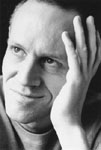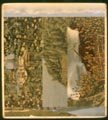daniel weiss 
des moines, iowa | interviewed
3-8-2002
biographical sketch | artist's statement | interview clips

"STORIES" series
collage/paintings
(click images for larger view)
all copyright © 2001 Daniel Weiss | All Rights Reserved
interview clips (mp3 audio & text)
Some people have to know their world by forming. History's full of those people. I got that package. I have to form to know, to understand. But I think, too, there's a certain amount of protest in being constructive. The world is very destructive. Things happen, whether they be family tragedies or just an overall sense of tragedy or doom or destruction of environment, of culture, that we live with daily. You protest that by being constructive, by finding beauty in things, by organizing—bringing order to a picture, to a song. When you're a teacher and a father, you have to model that life is about constructing, constructing, or I don't think you'd be very good at it.
It's very hard to teach high school today in America. The multitude of distractions. And so the teacher in me kicked in and said, I'm not changing my plans. And I was very disappointed that the other teachers did. It at one point became a, you can go down to one of several rooms and watch it on TV—which I still think was perfectly inappropriate. In times of destruction and tragedy, you remain calm. You are a model of peace and rationality. And that's how I handled that day. And I honestly did not ask, talk to, get any information until that evening when I got home. I was a teacher that day.
Then when I got home, I did turn on the news. Mostly I was concerned because I have a number of friends in New York City, and had a former student who had just taken a job in the second tower, 17th floor. So when I let my mind go there, I was scared, I must admit. But I remained focused and asked my students to do that.
I was demoralized, and still am. And I have to say, that the September 11th and the October 7th dates are two dates mixed into so many more. It's easy for me and you and all of us to sit there and pick these two dates out as significant dates. We live in a world where we've chosen violence as a way of solving things, as moving forward, as creating economies. And those are not the only two days of last calendar year where I was crushed, disheartened, and demoralized. They just aren't. Susan and I attended a peace rally on the steps of the Capitol, because I needed to be somewhere where there was some hope. I don't accept it. I will not accept this. Man, I got kids, and maybe grandkids. I do not accept that they will be in a world where violence is the way.
America is a place of great pluralism. We never melted into the pot, and I don't think we're going to. We come from so many places, and we need to take care of that. And so, if there is an American spirit, it is that. It is that, for me. It's what I think the rest of the world is looking at and watching in the American experiment. Can they really do this? Can they really be that different religiously, in ethnicity, culturally, and live side-by-side, and—not just tolerate and accept—nurture one another's differences. Can they really do that? I think it's well worth exploring. And if there is a spirit, that's the one I want to take part in. The one I don't like is the militaristic one.
In my heart, I think we need to move forward. We need to stop gauging everything from that place. And I honestly believe if you could contact those men and women and children who were in those airplanes, realizing they were headed for a skyscraper, they would tell you one thing. They would say, Get busy and create a world where no one flies into skyscrapers. We cannot come back. Make sure your energies, your resources, are about creating a world where people are not terrorized. No one, anywhere. And if you are going to be a superpower, realize that defense is in peace, it's in making sure everyone has what they need—that true peace is a result of justice. It's about looking at the big picture and realizing that we have a huge responsibility as a wealthy nation to this planet, and that a true defense is about defense of the planet.
biographical sketch
Daniel Weiss was born (1959) and raised in Mason City, Iowa. He is the eighth of ten children. His father's parents immigrated here from Russia. While he was growing up, he had two pivotal experiences: one, seeing a Mark Rothko painting in an encyclopedia, and two, visiting the Des Moines Art Center in eighth grade and knowing he had walked into his life—that he would be an artist.
He earned an A.A. degree in visual studies from the North Iowa Area Community College in Mason City, and a B.A. degree in art education from Iowa State University, Ames. He was an artist, consultant, educator, tutor, and taught visual studies at suburban Johnston High School.
He lived in Des Moines and had two children. He exhibited his work in Iowa and the Midwest, and was published in New American Paintings (Open Studios Press, v. 29). Sadly, Daniel died in October 2017.
artist's statement
(specific) I believe that this series and what it gave to me in its forming is pertinent to the destruction and construction that has been taking place in the American psyche since the pivotal events of September 11, 2001. In any event, it has been reaffirmed to me through my own disassembling and reassembling of lithographed postcards and the events in New York and Washington that there is always a great deal of construction that takes place in people as a result of destructive phenomena. All destruction constructs. This is powerful and will determine the future of our country. It both heartens and worries me to see a number of things happening in full force.
(general) The STORIES series began as a personal way of rethinking and reconstructing the history I was taught as a child. I began seeking ways of reconfigurating perceptions of America and my own American identity so that I could more effectively model that critical discourse in my classroom. Since we live in mass-mediated culture, I decided I would seek to confront media images of Americanism to reconstruct the constructed perceptions that I have.
I was not interested in using the political, propagandized images of American culture. I wanted to find, destruct and then reconstruct the ideas and even the objects that were and are used to portray history and American values to each and every next generation. In souvenir postcards collected for decades by my vacationing parents, I found images that promoted National Parks and famous eateries. I found images that glamorized militarism and stylized American dress and recreation in their depictions. With their painted-over artifice and ironically, their rich, litho'd palettes, I saw them as the very pieces I was looking for.
I created the 'de-constructions' after the Russian 'pi-lahfs' that are made along the river towns in Russia by devout Catholic women who, in their poverty, layer found bits of cardboard and paper scraps into intimate boards. The boards, created with sometimes over 70 layers of paper and cheap varnishes and shellacs, are then finished with brightly painted iconographic depictions of saints and/or the Madonna with the child Jesus. (I collected one years ago from a Russian peasant and have wanted to form something like one since then, as my father's people were from the Volga River region of Russia.) Using a process of Old World religious iconographic construction for the stories of American history seemed appropriate, in that many of my students, neighbors and relatives treat their American identity and experience as a religious, doctrinal thing. It interests me that many Americans venerate and are incapable of being critical of the people and stories of United States history.
My own STORIES are, then, explorations of my own people's past while being significant objects in the present, as they allow me to find new meaning in the reconstructing of the images, ideas and stories I was told while learning about American history. Each of the twelve STORIES holds its own private meaning for me. In one, I was able to take the color of fighter planes and ships to bring forth a story of lyrical pattern and calm, relative arrangements of shape. In another, I was able to tell a whole truth by juxtaposing fragmented indigenous landscapes with styles of European architecture. In all of them, I questioned the power of mass-mediated imagery and the values of self, history and future.
For me, the power of the aesthetic experience always brings new meaning and, in the case of the STORIES series, a firmer truth to the fact that history is not about what happened but rather it is about what was written down—what was created—about what happened. This allows you to move beyond your current perspective. This is about acknowledging the necessary destruction in constructing from an old vantage that is no longer productive or useful.





